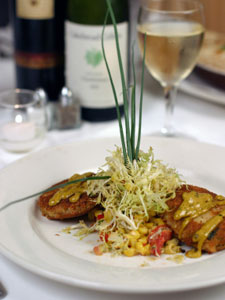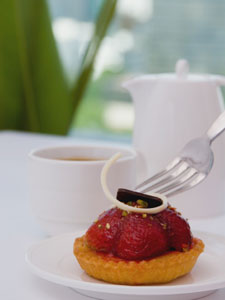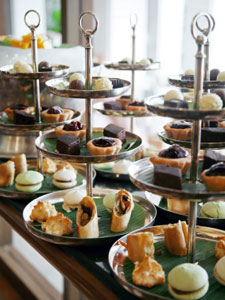Cup Meets Plate: Pairing Food with Tea



Think outside the cup.
In this session, we'll shift the focus from the taste of tea to the relationship tea can have with other tastes.
All too often, tea is lumped into the same category as coffee. So it makes sense that when some people think of pairing tea with foods, they ask themselves, "What works well with coffee?" However, most tea lovers will quickly tire of the limited choices (doughnuts and biscotti) available under this coupling. The most effective way to approach this subject is not through coffee, rather through another gourmet product known for its complementary nature: wine.
Any wine connoisseur can inform you that, while whites pair up with poultry and reds with meat, there are many wines that cross these lines. This revelation has led to many adventuresome pairings and new taste sensations in the wine world.
Fortunately, teas pairings are also open to exploration. It has been a standard in the West for decades that only black tea can be paired with foods and all others must stand alone. Countless Victorian tearooms provide all the proof necessary: a Summer Darjeeling served with cucumber finger sandwiches, cookies, and biscuits. It is rare to see a White Peony perform as an understudy. However, considering that Eastern countries drink green tea with nearly every meal, the time has come to reconsider tea's standards.
Delicate teas like nutty Dragonwell or fresh Sencha are wonderful with seafood, salads, or chicken. Bright and lively-flavored teas, such as the blacks from Sri Lanka or Assam, India, are great accompaniments to red meat or spicy foods from Mexico, Italy, or India. Although it is traditional to have Oolongs with Chinese dishes, one may argue that rich, spicy teas, like the black Yunnan or Keemun, offer more complexity and layers to the experience of tea pairings.
For desserts, seek out the chocolaty essence of a Golden Monkey or English Breakfast black tea. These exquisite Chinese teas are hearty, rich, and taste perfect when complementing baked custards, chocolate cakes, or a rich, dense strawberry shortcake. Assam is another rich black tea that complements chocolate desserts, yet is a surprising foil against lemony or custard dishes. Due to the naturally sweet, floral nature of a Jasmine, it is also ideal to serve with a dessert.
As a digestive, nothing is better, more satisfying or more calming than Pu-erh tea from China's Yunnan province. An aged, fermented tea, Pu'erh's clean, mellow, earthy quality is particularly good after a multiple-course feast like a Thanksgiving or similar heavy holiday meal. If you're a milk-and-cookies before bedtime type, try an herbal fruit infusion instead. You'll sleep better, and will wake up feeling great.
As an endnote, it is important to note that some teas, such as Formosa Oolong and Pouchong, seem to demand solo drinking, silence, and something restful to look upon. Or maybe that's just us.
The days when Earl Grey was sipped with a breakfast of scones and clotted cream are not gone, but make room on the table for some new, creative combos. With as many teas and foods as exist in the world, the possibilities are endless. The practice of pairing food with tea is not an exact science, but rather an art. Discovering what tastes fit individual palates is something that can only be done on the personal level.
 teaclass
teaclass
